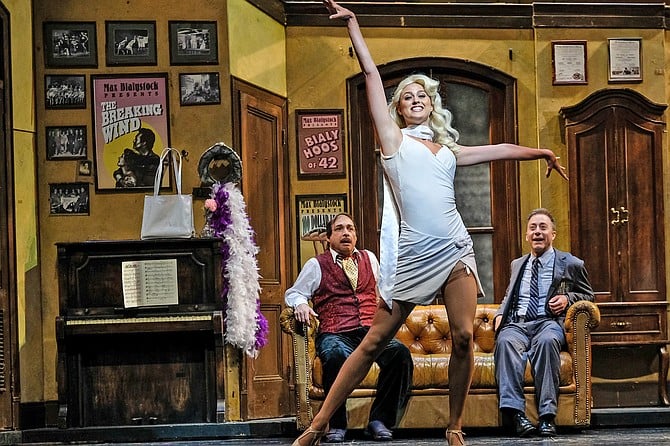 Facebook
Facebook
 X
X
 Instagram
Instagram
 TikTok
TikTok
 Youtube
Youtube

“Creative accounting” sets up the premise of the Mel Brooks movie turned musical The Producers, the story of two men who stage a Broadway musical designed to fail. The parodic idea is that the risk-reward scenario for live theater is so skewed, that producers stand a better chance of making money by overfunding a flop than they do paying back investors for a hit.
The original film was pointed enough in 1967. These days, were it not for Brooks’s broad, over-the-top brand of absurdist comedy, we might not even recognize The Producers as satire.
Most of the theaters propping up San Diego’s enviable theatrical calendar are registered nonprofits. Any of them will tell you the revenue generated by ticket sales generally covers about half the costs needed to stage a production, and it’s not investors they rely upon to cover the rest, but charitable contributors. That can be surprising when you approach a theater’s ticket window, and find out the cheap seats cost more than 30 bucks. Even community theater productions cost more than 20, and they certainly don’t have as many people to pay as a professional production.
Consider this musical production of The Producers being staged until June 29 at Vista’s Moonlight Amphitheatre, a decidedly professional outdoor theater rigged for pro sound and lighting, with a grand, elevated stage and an orchestra pit. Nevertheless, it offers some of the cheapest tickets in town — 17 bucks if you’re willing to sit on the grassy lawn above the back row of seats. But in addition to actors and directors, the show employs a broad range of tradespeople: light and sound techs, set designers and builders, costume designers and make up artists; not to mention the musicians in that pit. The number of people working full time on a single show can reach a hundred before you even consider staffing ticket sales, concessions, ushers, custodial staff, and security. And, speaking on behalf of those who work in print publishing, I can promise those glossy theater programs don’t write, photograph, and design themselves.
Considering such a layout of expenses, who even cares whether the producers get paid, right? Only the donors, it would seem. The real shocker about the people sitting in the good seats, the $60 or $90 per ticket seats, is that they’re often also the ones contributing behind the scenes cash to keep this whole theatrical rigmarole afloat. Those names we see embossed on a brick or a chair are effectively the investors the Producers’ namesake producers Bialystock and Bloom have convinced to financially back their flop. They’ll never see a monetary return on their investment, and can only hope the flops will provide high quality entertainment.
It’s hard to argue they don’t. When even the most successful theaters don’t turn a profit, that’s when you know they’re dealing in bona fide art.


“Creative accounting” sets up the premise of the Mel Brooks movie turned musical The Producers, the story of two men who stage a Broadway musical designed to fail. The parodic idea is that the risk-reward scenario for live theater is so skewed, that producers stand a better chance of making money by overfunding a flop than they do paying back investors for a hit.
The original film was pointed enough in 1967. These days, were it not for Brooks’s broad, over-the-top brand of absurdist comedy, we might not even recognize The Producers as satire.
Most of the theaters propping up San Diego’s enviable theatrical calendar are registered nonprofits. Any of them will tell you the revenue generated by ticket sales generally covers about half the costs needed to stage a production, and it’s not investors they rely upon to cover the rest, but charitable contributors. That can be surprising when you approach a theater’s ticket window, and find out the cheap seats cost more than 30 bucks. Even community theater productions cost more than 20, and they certainly don’t have as many people to pay as a professional production.
Consider this musical production of The Producers being staged until June 29 at Vista’s Moonlight Amphitheatre, a decidedly professional outdoor theater rigged for pro sound and lighting, with a grand, elevated stage and an orchestra pit. Nevertheless, it offers some of the cheapest tickets in town — 17 bucks if you’re willing to sit on the grassy lawn above the back row of seats. But in addition to actors and directors, the show employs a broad range of tradespeople: light and sound techs, set designers and builders, costume designers and make up artists; not to mention the musicians in that pit. The number of people working full time on a single show can reach a hundred before you even consider staffing ticket sales, concessions, ushers, custodial staff, and security. And, speaking on behalf of those who work in print publishing, I can promise those glossy theater programs don’t write, photograph, and design themselves.
Considering such a layout of expenses, who even cares whether the producers get paid, right? Only the donors, it would seem. The real shocker about the people sitting in the good seats, the $60 or $90 per ticket seats, is that they’re often also the ones contributing behind the scenes cash to keep this whole theatrical rigmarole afloat. Those names we see embossed on a brick or a chair are effectively the investors the Producers’ namesake producers Bialystock and Bloom have convinced to financially back their flop. They’ll never see a monetary return on their investment, and can only hope the flops will provide high quality entertainment.
It’s hard to argue they don’t. When even the most successful theaters don’t turn a profit, that’s when you know they’re dealing in bona fide art.
Comments